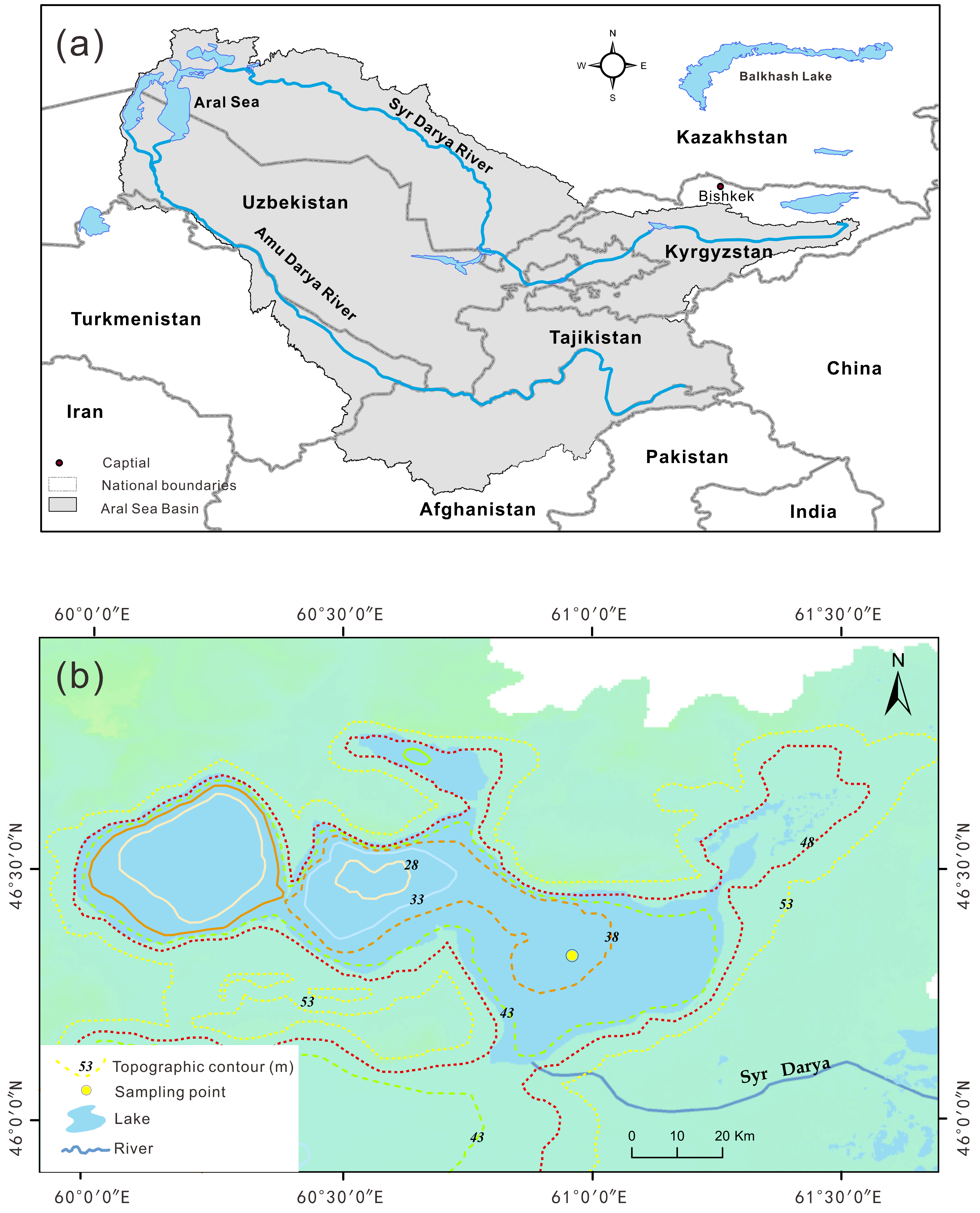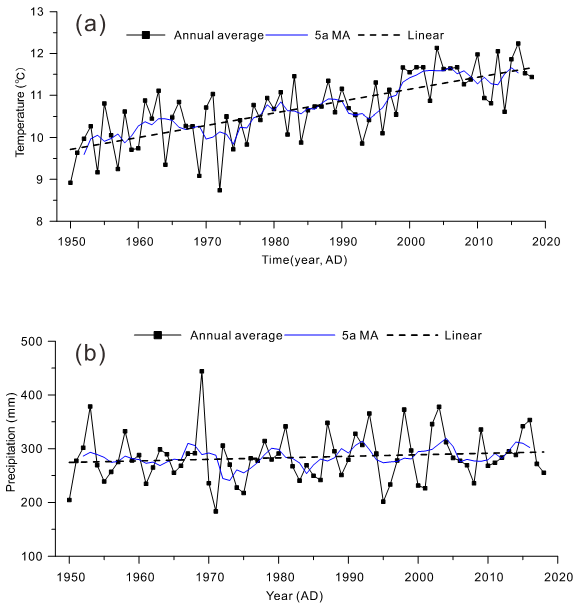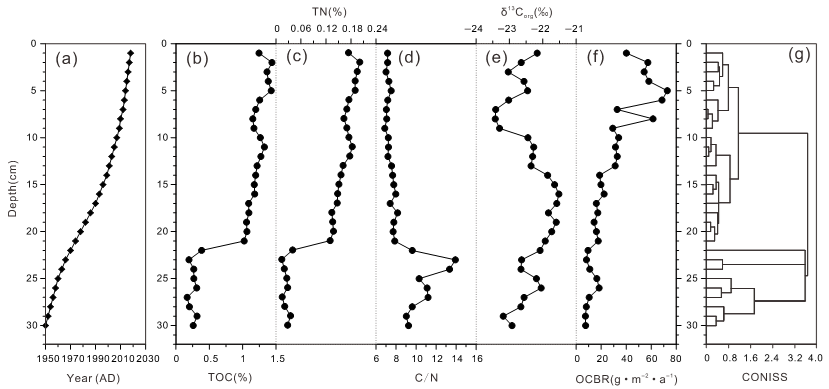Organic Carbon Burial in the Aral Sea of Central Asia
Abstract
:1. Introduction
2. Materials and Methods
2.1. Regional Setting
2.2. Sample Collection and Laboratory Analysis
2.3. Source Determination of Organic Carbon in the Sediments of the North Aral Sea
3. Results
3.1. Changes in the Organic Matter of the Lake Sediments
3.2. Stage Characteristics of Organic Proxies in the Sediments of the North Aral Sea
4. Discussion
5. Conclusions
Author Contributions
Funding
Institutional Review Board Statement
Informed Consent Statement
Data Availability Statement
Conflicts of Interest
References
- Isson, T.T.; Planavsky, N.J.; Coogan, L.A.; Stewart, E.M.; Ague, J.J.; Bolton, E.W.; Zhang, S.; McKenzie, N.R.; Kump, L.R. Evolution of the Global Carbon Cycle and Climate Regulation on Earth. Glob. Biogeochem. Cycles 2020, 34, e2018GB006061. [Google Scholar] [CrossRef]
- Dean, W.E.; Gorham, E. Magnitude and significance of carbon burial in lakes, reservoirs, and peatlands. Geology 1998, 26, 535–538. [Google Scholar] [CrossRef] [Green Version]
- Mendonça, R.; Müller, R.A.; Clow, D.; Verpoorter, C.; Raymond, P.; Tranvik, L.J.; Sobek, S. Organic carbon burial in global lakes and reservoirs. Nat. Commun. 2017, 8, 1694. [Google Scholar] [CrossRef] [Green Version]
- Toming, K.; Kotta, J.; Uuemaa, E.; Sobek, S.; Kutser, T.; Tranvik, L.J. Predicting lake dissolved organic carbon at a global scale. Sci. Rep. 2020, 10, 8471. [Google Scholar] [CrossRef]
- Ahlström, A.; Raupach, M.R.; Schurgers, G.; Smith, B.; Arneth, A.; Jung, M.; Reichstein, M.; Canadell, J.G.; Friedlingstein, P.; Jain, A.K.; et al. The dominant role of semi-arid ecosystems in the trend and variability of the land CO2 sink. Science 2015, 348, 895–899. [Google Scholar] [CrossRef] [Green Version]
- Chen, F.; Huang, W.; Jin, L.; Chen, J.; Wang, J. Spatiotemporal precipitation variations in the arid Central Asia in the context of global warming. Sci. China Earth Sci. 2011, 54, 1812–1821. [Google Scholar] [CrossRef]
- Liu, W.; Ma, L.; Abuduwaili, J. Anthropogenic Influences on Environmental Changes of Lake Bosten, the Largest Inland Freshwater Lake in China. Sustainability 2020, 12, 711. [Google Scholar] [CrossRef] [Green Version]
- Mischke, S.; Rajabov, I.; Mustaeva, N.; Zhang, C.; Herzschuh, U.; Boomer, I.; Brown, E.T.; Andersen, N.; Myrbo, A.; Ito, E.; et al. Modern hydrology and late Holocene history of Lake Karakul, eastern Pamirs (Tajikistan): A reconnaissance study. Palaeogeogr. Palaeoclim. Palaeoecol. 2010, 289, 10–24. [Google Scholar] [CrossRef]
- Wang, J.; Wu, J.; Zhan, S.; Zhou, J. Records of hydrological change and environmental disasters in sediments from deep Lake Issyk-Kul. Hydrol. Process. 2021, 35, e14136. [Google Scholar] [CrossRef]
- Huang, X.; Oberhänsli, H.; von Suchodoletz, H.; Prasad, S.; Sorrel, P.; Plessen, B.; Mathis, M.; Usubaliev, R. Hydrological changes in western Central Asia (Kyrgyzstan) during the Holocene as inferred from a palaeolimnological study in lake Son Kul. Quat. Sci. Rev. 2014, 103, 134–152. [Google Scholar] [CrossRef]
- Rosen, M.R.; Crootof, A.; Reidy, L.; Saito, L.; Nishonov, B.; Scott, J.A. The origin of shallow lakes in the Khorezm Province, Uzbekistan, and the history of pesticide use around these lakes. J. Paleolimnol. 2018, 59, 201–219. [Google Scholar] [CrossRef]
- Meyers, P.A.; Teranes, J.L. Sediment organic matter. In Tracking Environmental Change Using Lake Sediments; Springer: Berlin/Heidelberg, Germany, 2002; pp. 239–269. [Google Scholar]
- Song, C.; Dodds, W.K.; Rüegg, J.; Argerich, A.; Baker, C.L.; Bowden, W.B.; Douglas, M.M.; Farrell, K.J.; Flinn, M.B.; Garcia, E.A.; et al. Continental-scale decrease in net primary productivity in streams due to climate warming. Nat. Geosci. 2018, 11, 415–420. [Google Scholar] [CrossRef]
- Huang, K.; Ma, L.; Abuduwaili, J.; Liu, W.; Issanova, G.; Saparov, G.; Lin, L. Human-Induced Enrichment of Potentially Toxic Elements in a Sediment Core of Lake Balkhash, the Largest Lake in Central Asia. Sustainability 2020, 12, 4717. [Google Scholar] [CrossRef]
- Zhang, Y.; Su, Y.; Liu, Z.; Sun, K.; Kong, L.; Yu, J.; Jin, M. Sedimentary lipid biomarker record of human-induced environmental change during the past century in Lake Changdang, Lake Taihu basin, Eastern China. Sci. Total Environ. 2018, 613–614, 907–918. [Google Scholar] [CrossRef]
- Liu, W.; Ma, L.; Abuduwaili, J. Historical Change and Ecological Risk of Potentially Toxic Elements in the Lake Sediments from North Aral Sea, Central Asia. Appl. Sci. 2020, 10, 5623. [Google Scholar] [CrossRef]
- Wurtsbaugh, W.A.; Miller, C.; Null, S.E.; DeRose, R.J.; Wilcock, P.; Hahnenberger, M.; Howe, F.; Moore, J. Decline of the world’s saline lakes. Nat. Geosci. 2017, 10, 816. [Google Scholar] [CrossRef]
- Micklin, P. The Aral Sea Disaster. Annu. Rev. Earth Planet. Sci. 2007, 35, 47–72. [Google Scholar] [CrossRef] [Green Version]
- Pavelsky, T.M. World’s landlocked basins drying. Nat. Geosci. 2018, 11, 892–893. [Google Scholar] [CrossRef]
- Liu, H.; Chen, Y.; Ye, Z.; Li, Y.; Zhang, Q. Recent Lake Area Changes in Central Asia. Sci. Rep. 2019, 9, 16277. [Google Scholar] [CrossRef] [Green Version]
- Micklin, P. The future Aral Sea: Hope and despair. Environ. Earth Sci. 2016, 75, 844. [Google Scholar] [CrossRef]
- Gaybullaev, B.; Chen, S.-C.; Gaybullaev, D. Changes in water volume of the Aral Sea after 1960. Appl. Water Sci. 2012, 2, 285–291. [Google Scholar] [CrossRef] [Green Version]
- Massakbayeva, A.; Abuduwaili, J.; Bissenbayeva, S.; Issina, B.; Smanov, Z. Water balance of the Small Aral Sea. Environ. Earth Sci. 2020, 79, 75. [Google Scholar] [CrossRef]
- Ys, A.; Xin, L.B.; Min, F.B.; Yn, A.; Lh, A.; Tx, A.; Kz, B.; Feng, C.; Wei, H.A.; Jc, A. High agricultural water consumption led to the continued shrinkage of the Aral Sea during 1992–2015. Sci. Total Environ. 2021, 777, 145993. [Google Scholar]
- Alexyuk, M.; Bogoyavlenskiy, A.; Alexyuk, P.; Moldakhanov, Y.; Berezin, V.; Digel, I. Epipelagic microbiome of the Small Aral Sea: Metagenomic structure and ecological diversity. MicrobiologyOpen 2021, 10, e1142. [Google Scholar] [CrossRef] [PubMed]
- Izhitskiy, A.S.; Zavialov, P.O.; Sapozhnikov, P.V.; Kirillin, G.B.; Grossart, H.P.; Kalinina, O.Y.; Zalota, A.K.; Goncharenko, I.V.; Kurbaniyazov, A.K. Present state of the Aral Sea: Diverging physical and biological characteristics of the residual basins. Sci. Rep. 2016, 6, 23906. [Google Scholar] [CrossRef] [Green Version]
- Namsaraev, Z.B. Microbial Communities of the Central Asian Lakes as Indicators of Climatic and Ecological Changes in the Region. Microbiology 2018, 87, 534–537. [Google Scholar] [CrossRef]
- Li, Q.; Li, X.; Ran, Y.; Feng, M.; Nian, Y.; Tan, M.; Chen, X. Investigate the relationships between the Aral Sea shrinkage and the expansion of cropland and reservoir in its drainage basins between 2000 and 2020. Int. J. Digit. Earth 2021, 14, 661–677. [Google Scholar] [CrossRef]
- Deliry, S.I.; Avdan, Z.Y.; Do, N.T.; Avdan, U. Assessment of human-induced environmental disaster in the Aral Sea using Landsat satellite images. Environ. Earth Sci. 2020, 79, 471. [Google Scholar] [CrossRef]
- Jin, Q.; Wei, J.; Yang, Z.-L.; Lin, P. Irrigation-Induced Environmental Changes around the Aral Sea: An Integrated View from Multiple Satellite Observations. Remote Sens. 2017, 9, 900. [Google Scholar] [CrossRef] [Green Version]
- Wu, T.; Sang, S.; Wang, S.; Yang, Y.; Li, M. Remote sensing assessment and spatiotemporal variations analysis of ecological carrying capacity in the Aral Sea Basin. Sci. Total Environ. 2020, 735, 139562. [Google Scholar] [CrossRef]
- Wang, J.; Liu, D.; Ma, J.; Cheng, Y.; Wang, L. Development of a large-scale remote sensing ecological index in arid areas and its application in the Aral Sea Basin. J. Arid. Land 2021, 13, 40–55. [Google Scholar] [CrossRef]
- Chen, F.-H.; Chen, J.; Holmes, J.; Boomer, I.; Austin, P.; Gates, J.B.; Wang, N.-L.; Brooks, S.J.; Zhang, J.-W. Moisture changes over the last millennium in arid central Asia: A review, synthesis and comparison with monsoon region. Quat. Sci. Rev. 2010, 29, 1055–1068. [Google Scholar] [CrossRef]
- Burr, G.; Kuzmin, Y.; Krivonogov, S.; Gusskov, S.; Cruz, R. A history of the modern Aral Sea (Central Asia) since the Late Pleistocene. Quat. Sci. Rev. 2019, 206, 141–149. [Google Scholar] [CrossRef]
- Breckle, S.W.; Geldyeva, G.V. Dynamics of the Aral Sea in Geological and Historical Times. In Aralkum—A Man-Made Desert: The Desiccated Floor of the Aral Sea (Central Asia); Breckle, S.-W., Wucherer, W., Dimeyeva, L.A., Ogar, N.P., Eds.; Springer: Berlin/Heidelberg, Germany, 2012; pp. 13–35. [Google Scholar]
- Sorrel, P.; Oberhänsli, H.; Boroffka, N.; Nourgaliev, D.; Dulski, P.; Röhl, U. Control of wind strength and frequency in the Aral Sea basin during the late Holocene. Quat. Res. 2007, 67, 371–382. [Google Scholar] [CrossRef]
- Badescu, V.; Schuiling, R.D. Aral Sea; Irretrievable Loss or Irtysh Imports? Water Resour. Manag. 2010, 24, 597–616. [Google Scholar] [CrossRef]
- Harris, I.; Osborn, T.J.; Jones, P.; Lister, D. Version 4 of the CRU TS monthly high-resolution gridded multivariate climate dataset. Sci. Data 2020, 7, 109. [Google Scholar] [CrossRef] [Green Version]
- Wu, J.; Ma, L.; Yu, H.; Zeng, H.; Liu, W.; Abuduwaili, J. Sediment geochemical records of environmental change in Lake Wuliangsu, Yellow River Basin, north China. J. Paleolimnol. 2013, 50, 245–255. [Google Scholar] [CrossRef]
- Meyers, P.; Ishiwatari, R. Lacustrine organic geochemistry—An overview of indicators of organic matter sources and diagenesis in lake sediments. Org. Geochem. 1993, 20, 867–900. [Google Scholar] [CrossRef] [Green Version]
- Wang, Y.; Zhu, L.; Wang, J.; Ju, J.; Lin, X. The spatial distribution and sedimentary processes of organic matter in surface sediments of Nam Co, Central Tibetan Plateau. Chin. Sci. Bull. 2012, 57, 4753–4764. [Google Scholar] [CrossRef] [Green Version]
- Wang, Y.; Yang, J.; Chen, Y.; Wang, A.; De Maeyer, P. The Spatiotemporal Response of Soil Moisture to Precipitation and Temperature Changes in an Arid Region, China. Remote Sens. 2018, 10, 468. [Google Scholar] [CrossRef] [Green Version]
- Meyers, P.; Lallier-Vergés, E. Lacustrine Sedimentary Organic Matter Records of Late Quaternary Paleoclimates. J. Paleolimnol. 1999, 21, 345–372. [Google Scholar] [CrossRef]
- Wooldridge, S.T.H. Origin and trophic importance of detritus-evidence from stable isotopes in the benthos of a small, temperate estuary. Oecologia 1996, 106, 382–388. [Google Scholar]
- Thorp, J.H.; Delong, M.D.; Greenwood, K.S.; Casper, A. Isotopic analysis of three food web theories in constricted and floodplain regions of a large river. Oecologia 1998, 117, 551–563. [Google Scholar] [CrossRef]
- Kendall, C.; Silva, S.R.; Kelly, V.J. Carbon and nitrogen isotopic compositions of particulate organic matter in four large river systems across the United States. Hydrol. Process. 2001, 15, 1301–1346. [Google Scholar] [CrossRef]
- Shen, J.; Wang, Y.; Liu, X.Q.; Matsumoto, R. A 16 ka climate record deduced from δ~(13)C and C/N ratio in Qinghai Lake sediments, northeastern Tibetan Plateau. Chin. J. Oceanol. Limnol. 2006, 24, 103–110. [Google Scholar]
- Contreras, S.; Werne, J.P.; Araneda, A.; Urrutia, R.; Conejero, C.A. Organic matter geochemical signatures (TOC, TN, C/N ratio, δ13C and δ15N) of surface sediment from lakes distributed along a climatological gradient on the western side of the southern Andes. Sci. Total Environ. 2018, 630, 878–888. [Google Scholar] [CrossRef]
- Liu, W.; Li, X.; Zheng, W.; Wang, H.; Hu, L.; Bo, Z.; Zhang, H. Carbon isotope and environmental changes in lakes in arid Northwest China. Sci. China-Earth Sci. 2018, 62, 1193–1206. [Google Scholar] [CrossRef]
- Lone, A.M.; Fousiya, A.A.; Shah, R.A.; Achyuthan, H. Reconstruction of Paleoclimate and Environmental Fluctuations Since the Early Holocene Period Using Organic Matter and C:N Proxy Records: A Review. J. Geol. Soc. India 2018, 91, 209–214. [Google Scholar] [CrossRef]
- Grimm, E.C. CONISS: A FORTRAN 77 program for stratigraphically constrained cluster analysis by the method of incremental sum of squares. Comput. Geosci. 1987, 13, 13–35. [Google Scholar] [CrossRef]
- Ma, L.; Wu, J.; Abuduwaili, J. Climate and environmental changes over the past 150 years inferred from the sediments of Chaiwopu Lake, central Tianshan Mountains, northwest China. Int. J. Earth Sci. 2012, 102, 959–967. [Google Scholar] [CrossRef]
- Lin, Q.; Liu, E.; Zhang, E.; Nath, B.; Bindler, R.; Liu, J.; Shen, J. Organic carbon burial in a large, deep alpine lake (southwest China) in response to changes in climate, land use and nutrient supply over the past ~100 years. Catena 2021, 202, 105240. [Google Scholar] [CrossRef]
- Li, Y.; Li, X.; Huang, G.; Wang, S.; Li, D. Sedimentary organic carbon and nutrient distributions in an endorheic lake in semiarid area of the Mongolian Plateau. J. Environ. Manag. 2021, 296, 113184. [Google Scholar] [CrossRef]
- Li, H.; Song, C.-L.; Cao, X.-Y.; Zhou, Y.-Y. The phosphorus release pathways and their mechanisms driven by organic carbon and nitrogen in sediments of eutrophic shallow lakes. Sci. Total Environ. 2016, 572, 280–288. [Google Scholar] [CrossRef] [PubMed]
- Jude, K.A.; Giorgio, P.A.d.; Kemp, W.M. Temperature regulation of bacterial production, respiration, and growth efficiency in a temperate salt-marsh estuary. Aquat. Microb. Ecol. 2006, 43, 243–254. [Google Scholar]
- Danovaro, R.; Corinaldesi, C.; Dell’Anno, A.; Rastelli, E. Potential impact of global climate change on benthic deep-sea microbes. FEMS Microbiol. Lett. 2017, 364, fnx214. [Google Scholar] [CrossRef]
- Yang, X.; Wang, N.; Chen, A.; He, J.; Hua, T.; Qie, Y. Changes in area and water volume of the Aral Sea in the arid Central Asia over the period of 1960–2018 and their causes. Catena 2020, 191, 104566. [Google Scholar] [CrossRef]
- Cretaux, J.F.; Letolle, R.; Bergé-Nguyen, M. History of Aral Sea level variability and current scientific debates. Global Planet. Change 2013, 110, 99–113. [Google Scholar] [CrossRef]
- Post, W.M.; Emanuel, W.R.; Zinke, P.J.; Stangenberger, A.G. Soil carbon pools and world life zones. Nat. Cell Biol. 1982, 298, 156–159. [Google Scholar] [CrossRef]
- Hontoria, C.; Saa, A.; Rodríguez-Murillo, J.C. Relationships Between Soil Organic Carbon and Site Characteristics in Peninsular Spain. Soil Sci. Soc. Am. J. 1999, 63, 614–621. [Google Scholar] [CrossRef] [Green Version]
- Micklin, P. The past, present, and future Aral Sea. Lakes Reserv. Res. Manag. 2010, 15, 193–213. [Google Scholar]
- Aladin, N.; Cre´Taux, J.; Plotnikov, I.S.; Kouraev, A.V.; Smurov, A.O. Modern hydro-biological state of the Small Aral sea. Environ. Off. J. Int. Environ. Soc. 2010, 16, 375–392. [Google Scholar] [CrossRef] [Green Version]
- Woulds, C.; Bouillon, S.; Cowie, G.L.; Drake, E.; Middelburg, J.J.; Witte, U. Patterns of carbon processing at the seafloor: The role of faunal and microbial communities in moderating carbon flows. Biogeosciences 2016, 13, 4343–4357. [Google Scholar] [CrossRef] [Green Version]
- Sobek, S.; Durisch-Kaiser, E.; Zurbrügg, R.; Wongfun, N.; Wessels, M.; Pasche, N.; Wehrli, B. Organic carbon burial efficiency in lake sediments controlled by oxygen exposure time and sediment source. Limnol. Oceanogr. 2009, 54, 2243–2254. [Google Scholar] [CrossRef] [Green Version]
- Rissanen, A.J.; Saarela, T.; Jäntti, H.; Buck, M.; Peura, S.; Aalto, S.L.; Ojala, A.; Pumpanen, J.; Tiirola, M.; Elvert, M.; et al. Vertical stratification patterns of methanotrophs and their genetic controllers in water columns of oxygen-stratified boreal lakes. FEMS Microbiol. Ecol. 2020, 97, fiaa252. [Google Scholar] [CrossRef]
- Grettenberger, C.L.; McCauley Rench, R.L.; Gruen, D.S.; Mills, D.B.; Carney, C.; Brainard, J.; Hamasaki, H.; Ramirez, R.; Watanabe, Y.; Amaral-Zettler, L.A.; et al. Microbial population structure in a stratified, acidic pit lake in the Iberian Pyrite Belt. Geomicrobiol. J. 2020, 37, 623–634. [Google Scholar] [CrossRef]
- Rastelli, E.; Corinaldesi, C.; Petani, B.; Dell’Anno, A.; Ciglenečki, I.; Danovaro, R. Enhanced viral activity and dark CO2 fixation rates under oxygen depletion: The case study of the marine Lake Rogoznica. Environ. Microbiol. 2016, 18, 4511–4522. [Google Scholar] [CrossRef]




Publisher’s Note: MDPI stays neutral with regard to jurisdictional claims in published maps and institutional affiliations. |
© 2021 by the authors. Licensee MDPI, Basel, Switzerland. This article is an open access article distributed under the terms and conditions of the Creative Commons Attribution (CC BY) license (https://creativecommons.org/licenses/by/4.0/).
Share and Cite
Feng, S.; Ma, L.; Abuduwaili, J.; Liu, W.; Saparov, G.; Issanova, G. Organic Carbon Burial in the Aral Sea of Central Asia. Appl. Sci. 2021, 11, 7135. https://doi.org/10.3390/app11157135
Feng S, Ma L, Abuduwaili J, Liu W, Saparov G, Issanova G. Organic Carbon Burial in the Aral Sea of Central Asia. Applied Sciences. 2021; 11(15):7135. https://doi.org/10.3390/app11157135
Chicago/Turabian StyleFeng, Sen, Long Ma, Jilili Abuduwaili, Wen Liu, Galymzhan Saparov, and Gulnura Issanova. 2021. "Organic Carbon Burial in the Aral Sea of Central Asia" Applied Sciences 11, no. 15: 7135. https://doi.org/10.3390/app11157135
APA StyleFeng, S., Ma, L., Abuduwaili, J., Liu, W., Saparov, G., & Issanova, G. (2021). Organic Carbon Burial in the Aral Sea of Central Asia. Applied Sciences, 11(15), 7135. https://doi.org/10.3390/app11157135





